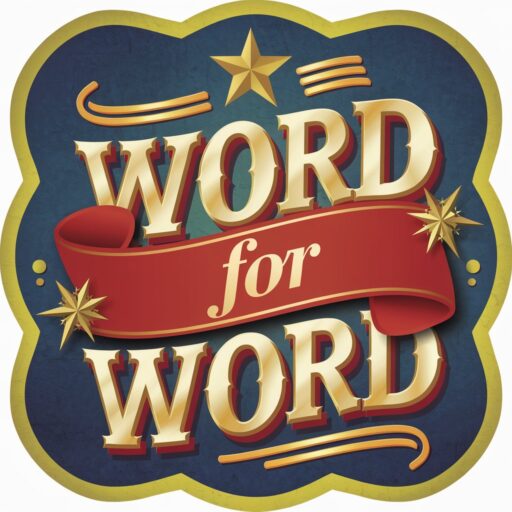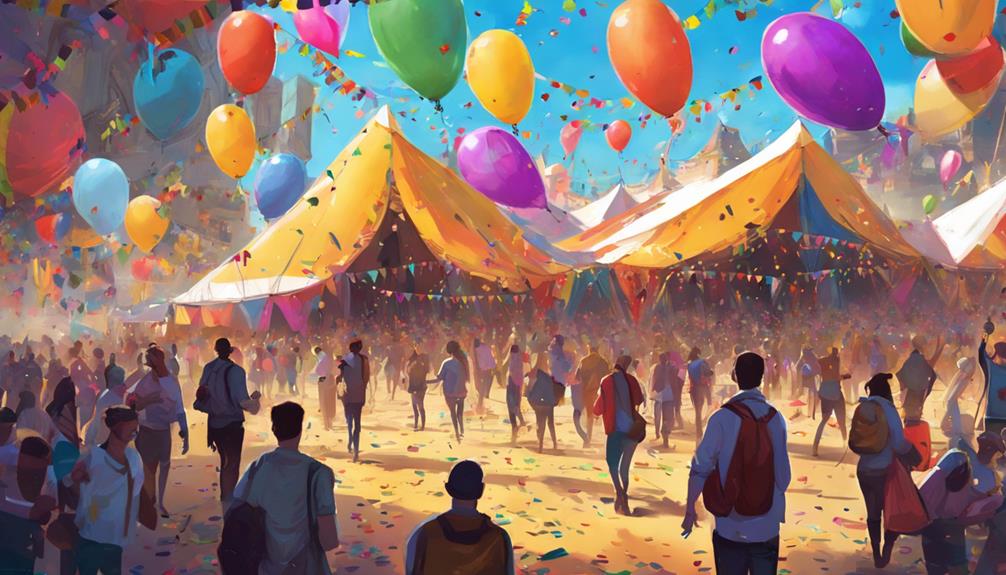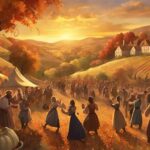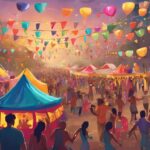When writing a festival description, you'll want to define your festival's unique identity, highlighting its cultural significance, stunning natural settings, and vibrant atmosphere. Identify your target audience and use sensory language to evoke emotions, transporting them to the festival atmosphere. Emphasize key events, activities, and exclusive experiences that set your festival apart. Create a sense of anticipation with limited-time offers, urgency, and social proof. To truly bring your festival to life, craft descriptions that showcase the energy, excitement, and unique experiences. Want to discover more insider secrets to making your festival description unforgettable?
Key Takeaways
- Define your festival's unique identity through branding, cultural significance, and natural settings.
- Identify your target audience by demographics, characteristics, and interests.
- Use sensory language and vivid descriptions to create an immersive festival experience.
- Highlight key events and activities with concise descriptions and creativity.
Define Your Festival's Unique Identity
When it comes to crafting a festival description that really pops, you'll want to start by defining what sets your festival apart from the rest – its unique identity.
This is where festival branding comes in, and it's essential to get it right.
Think about what makes your festival special – is it the cultural significance of the music, food, or art on display?
Is it the stunning natural setting or the vibrant atmosphere?
Whatever it is, make sure to highlight it in your description.
Your festival's unique identity is what'll draw people in and make them want to attend.
Identify Your Target Audience
You're crafting a festival description that'll make people swoon, but who are these people?
It's time to pinpoint your perfect audience by considering the nitty-gritty details that define them, like demographics, age, and location. These will help you tailor your description to resonate with them on a deeper level.
As you explore the specifics of your target audience, remember that psychographics also play a starring role. What drives them, what are they passionate about, and what gets them excited?
Demographics and Interests
To effectively promote your festival, it's essential to pinpoint your target audience by considering the demographics and interests that'll resonate with the unique vibe and offerings of your event.
When thinking about festival demographics, ask yourself: what're the characteristics of the people who'll be most drawn to your festival? Are they families, young professionals, or retirees?
What're their interests, hobbies, or passions? Are they music lovers, foodies, or adventure-seekers?
By understanding your audience's interests, you can tailor your festival description to speak directly to them.
Think about the types of activities, performances, or experiences that'll spark their excitement and curiosity.
What'll make them want to attend your festival and share it with their friends?
Age and Location Matter
Identifying your target audience is essential, and it starts with pinpointing the age groups and locations that'll be most drawn to your festival. Are you catering to families with young kids in suburban areas or attracting young adults in urban hubs? Knowing your age demographics is key to creating a festival that resonates with your audience.
Consider the age ranges that'll be most interested in your festival's music, food, and activities. Location trends also play a significant role. Are you situated in a trendy neighborhood that'll draw in a hipster crowd or in a family-friendly park that'll attract parents with strollers?
Understanding these factors will help you tailor your festival description to speak directly to your target audience. By doing so, you'll increase the likelihood of attracting the right crowd and making your festival a success.
Psychographics Play Role
When it comes to crafting a festival description that truly resonates, it's not just about the age and location of your target audience – it's also about understanding what makes them tick, what they're passionate about, and what they value, which is where psychographics come in.
You want to tap into their festival motivations – what drives them to attend, what they hope to experience, and what they'll take away. By understanding their values, interests, and lifestyle, you can create a description that speaks directly to them, fostering audience engagement and excitement.
Ask yourself: What're their hobbies? What kind of music do they enjoy? What kind of atmosphere are they looking for?
Use Sensory Language Effectively
Now it's time to bring your festival to life with sensory language that'll make your audience feel like they're already there.
You'll want to craft vivid descriptions that appeal to your readers' senses, transporting them to a world of color, sound, and excitement.
Vivid Imagery Techniques
As you craft your festival description, you're not just listing events – you're painting a picture that'll transport your audience to the vibrant scene, so use sensory language to bring the sights, sounds, and sensations to life.
To create vivid imagery, focus on sensory details that appeal to your audience's senses. Describe the sweet aroma of food vendors, the sound of laughter and music, and the feeling of sun on skin or confetti in the air.
Use imagery techniques like metaphors and similes to add depth and creativity to your description. For example, "The smell of sizzling burgers wafted through the air like a flavorful cloud" or "The music pulsed like a heartbeat, energizing the crowd."
Evoking Emotions Through Description
You're not just painting a picture with your festival description – you're crafting an emotional experience that'll resonate with your audience, so use sensory language to tap into their feelings and desires, making them feel like they're already part of the celebration.
To evoke emotions, focus on the sensations and memories associated with the festival. Use narrative techniques like storytelling and metaphors to create a sense of nostalgia, excitement, or wonder.
For example, instead of saying 'there will be food,' say 'savor the aroma of sizzling street food that'll transport you to a world of flavors.' By doing so, you'll create an emotional resonance that'll make your audience yearn to be part of the festival.
Use sensory language effectively to craft a description that's both vivid and evocative, drawing your audience in and refusing to let go.
Describing Sights and Sounds
When describing the sights and sounds of your festival, it's not just about listing what people will see and hear – it's about crafting a multisensory experience that'll leave them feeling like they're right in the midst of the action.
You're not just writing a description; you're creating a visual storytelling experience that'll transport your readers to the festival grounds.
Use sensory language to bring the sights and sounds to life – describe the vibrant colors of the stage lights, the thumping bass of the music, and the mouth-watering aromas of the food vendors.
By doing so, you'll create immersive experiences that'll make your readers feel like they're part of the festival, even if they're just reading about it.
This will help them connect with your festival on a deeper level and make them more likely to attend.
Highlight Key Events and Activities
To create a festival description that really pops, highlight three to five key events and activities that'll make your festival stand out from the crowd and leave attendees enthusiastic to experience them firsthand.
When deciding which events to highlight, think about what sets your festival apart. Are you showcasing performers who are making their festival debut? Make sure to mention that!
Are you highlighting traditions that are unique to your festival? Give readers a sneak peek into what they can expect.
By highlighting these key events and activities, you'll create a buzz around your festival and entice attendees to come and experience it for themselves.
Be creative and concise in your descriptions, and make sure to include all the details that'll get readers excited!
Create a Sense of Anticipation
By emphasizing the exclusivity and rarity of your festival's offerings, attendees will enthusiastically anticipate experiencing something they won't find anywhere else, and they'll be counting down the days until the gates open.
To create a sense of anticipation, use techniques that build excitement, like revealing headlining acts or special guests in the weeks leading up to the festival. You can also create limited-time offers or exclusive experiences that make attendees feel like they're part of a special group.
Use language that evokes a sense of urgency and scarcity, like 'limited spots available' or 'only a few days left to get tickets.'
Use Social Proof and Testimonials
As you craft your festival description, incorporating social proof and testimonials from past attendees, performers, or industry experts can be a powerful way to build credibility and trust with potential attendees.
This approach makes them more likely to buy into the experience you're offering. Think about it – when you're considering trying a new restaurant or buying a product, don't you look for reviews and ratings from others who've had a similar experience?
It's the same with festivals. By including social proof and testimonials in your description, you're giving potential attendees a sense of what to expect and reassuring them that they're in good company.
Use powerful testimonials to highlight the best aspects of your festival and make it impossible for readers to resist joining the fun!
Emphasize the Festival Experience
Your festival is more than just a series of events – it's an immersive experience that will leave a lasting impression on attendees, so make sure your description captures the essence of what makes it unforgettable.
You want to transport potential attendees into the heart of your festival, making them feel the energy and excitement.
Highlight the cultural significance of your festival, whether it's a celebration of music, art, or food.
Emphasize the unique experiences that set your festival apart, such as interactive installations or workshops.
Use vivid language to paint a picture of the sights, sounds, and emotions that attendees will experience.
Keep It Concise and Scannable
When you're crafting a festival description, it's essential to keep it concise and scannable, so readers can quickly grasp the excitement and essence of your event without getting bogged down in too much detail.
To achieve this, focus on using concise language and a scannable format.
Here are three key tips:
- Break up long paragraphs into shorter ones to improve readability and flow.
- Use bullet points and lists to highlight key features, such as performer lineups, food options, or activities.
- Bold and italicize key words to draw attention to important details, like dates, times, and ticket prices.
Optimize for Search Engines
You're one step closer to making your festival description shine, and now it's time to think about how to make it discoverable by the right people – which means optimizing it for search engines.
Think of it like throwing a party – you want to make sure the right guests show up! To do this, you'll need to do some keyword research to figure out what words and phrases people are searching for when looking for festivals like yours.
Use those keywords in your description, especially in your meta descriptions, which are like the party invitation that search engines see.
Keep it concise and compelling, and make sure it accurately reflects the greatness of your festival.
Conclusion
You've got the tools to craft a festival description that'll draw in the crowds!
By defining your unique identity, identifying your target audience, and using sensory language, you'll create a buzzworthy event that'll leave attendees enthusiastic for more.
Don't forget to highlight key events, create anticipation, and use social proof to seal the deal.
Keep it concise, scannable, and optimized for search engines, and you'll be well on your way to creating an unforgettable festival experience!



